CHEVROLET EQUINOX 2007 1.G User Guide
Manufacturer: CHEVROLET, Model Year: 2007, Model line: EQUINOX, Model: CHEVROLET EQUINOX 2007 1.GPages: 492, PDF Size: 2.62 MB
Page 11 of 492

Manual Reclining Seatbacks
{CAUTION:
You can lose control of the vehicle if
you try to adjust a manual driver’s seat
while the vehicle is moving. The sudden
movement could startle and confuse you,
or make you push a pedal when you do
not want to. Adjust the driver’s seat only
when the vehicle is not moving.
{CAUTION:
If the seatback is not locked, it could
move forward in a sudden stop or crash.
That could cause injury to the person
sitting there. Always push and pull on
the seatback to be sure it is locked.To adjust the seatback on the driver’s seat, lift the
lever on the rear outboard side of the seat and
move the seatback to the desired position. Then
release the lever to lock the seatback in place.
Driver’s Seat with Manual Recline and
Manual Height Adjuster shown
11
Page 12 of 492

To adjust the seatback on the front passenger’s
seat, lift the lever on the outboard side of the seat
and move the seatback to the desired position.
Then release the lever to lock the seatback
in place. If your front passenger’s seat is a �at
folding seat, you must fully raise the lever to
disengage the seatback.
Passenger Seat with Folding Seatback
Option shown
12
Page 13 of 492
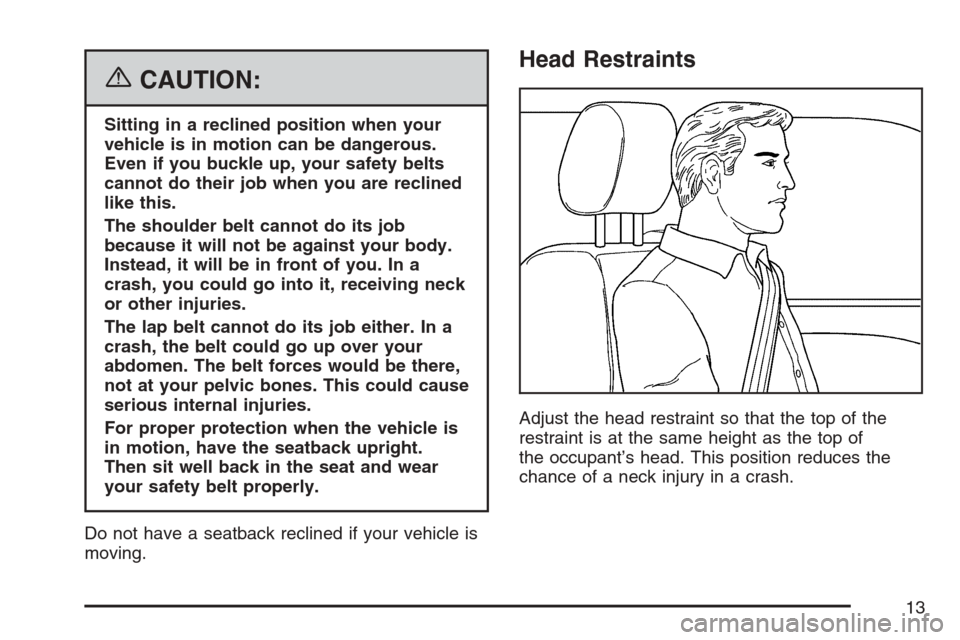
{CAUTION:
Sitting in a reclined position when your
vehicle is in motion can be dangerous.
Even if you buckle up, your safety belts
cannot do their job when you are reclined
like this.
The shoulder belt cannot do its job
because it will not be against your body.
Instead, it will be in front of you. In a
crash, you could go into it, receiving neck
or other injuries.
The lap belt cannot do its job either. In a
crash, the belt could go up over your
abdomen. The belt forces would be there,
not at your pelvic bones. This could cause
serious internal injuries.
For proper protection when the vehicle is
in motion, have the seatback upright.
Then sit well back in the seat and wear
your safety belt properly.
Do not have a seatback reclined if your vehicle is
moving.
Head Restraints
Adjust the head restraint so that the top of the
restraint is at the same height as the top of
the occupant’s head. This position reduces the
chance of a neck injury in a crash.
13
Page 14 of 492
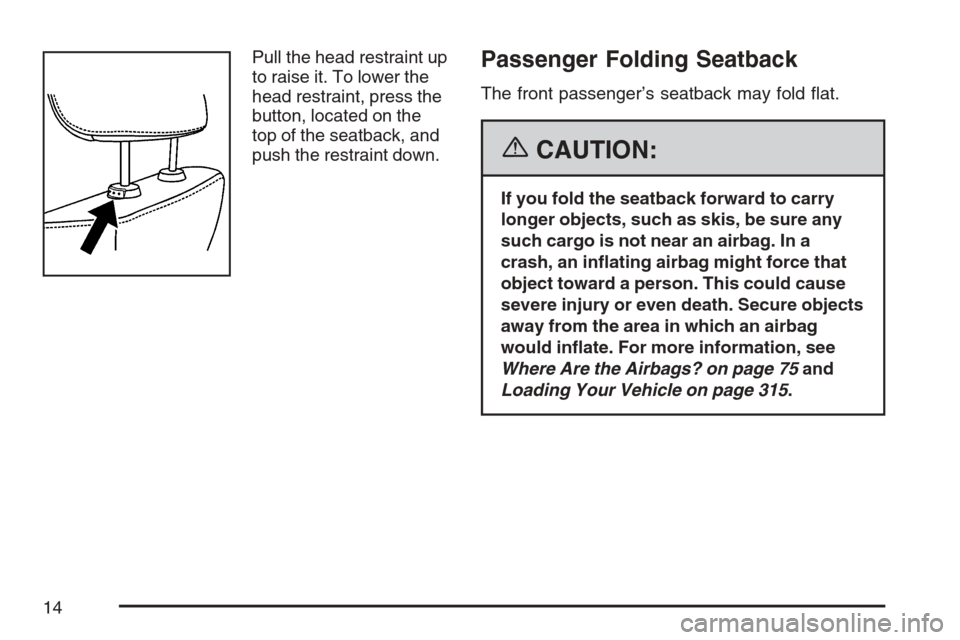
Pull the head restraint up
to raise it. To lower the
head restraint, press the
button, located on the
top of the seatback, and
push the restraint down.Passenger Folding Seatback
The front passenger’s seatback may fold �at.
{CAUTION:
If you fold the seatback forward to carry
longer objects, such as skis, be sure any
such cargo is not near an airbag. In a
crash, an in�ating airbag might force that
object toward a person. This could cause
severe injury or even death. Secure objects
away from the area in which an airbag
would in�ate. For more information, see
Where Are the Airbags? on page 75and
Loading Your Vehicle on page 315.
14
Page 15 of 492
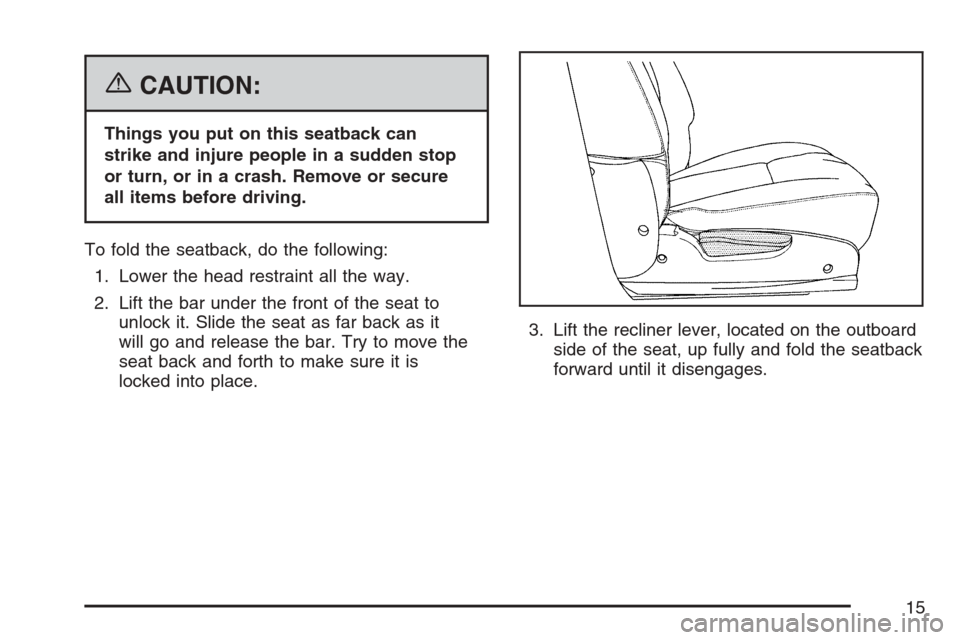
{CAUTION:
Things you put on this seatback can
strike and injure people in a sudden stop
or turn, or in a crash. Remove or secure
all items before driving.
To fold the seatback, do the following:
1. Lower the head restraint all the way.
2. Lift the bar under the front of the seat to
unlock it. Slide the seat as far back as it
will go and release the bar. Try to move the
seat back and forth to make sure it is
locked into place.3. Lift the recliner lever, located on the outboard
side of the seat, up fully and fold the seatback
forward until it disengages.
15
Page 16 of 492
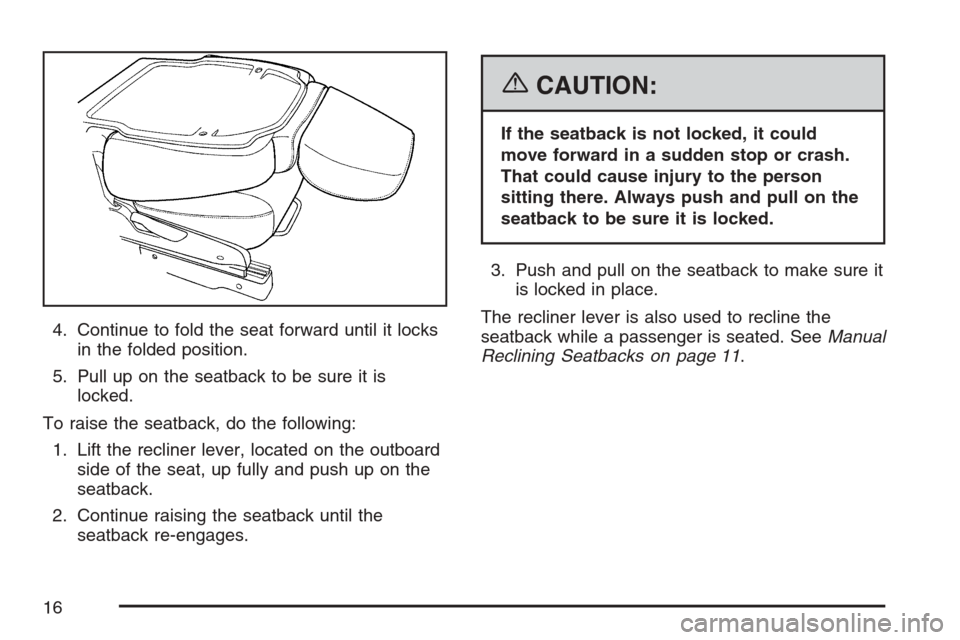
4. Continue to fold the seat forward until it locks
in the folded position.
5. Pull up on the seatback to be sure it is
locked.
To raise the seatback, do the following:
1. Lift the recliner lever, located on the outboard
side of the seat, up fully and push up on the
seatback.
2. Continue raising the seatback until the
seatback re-engages.
{CAUTION:
If the seatback is not locked, it could
move forward in a sudden stop or crash.
That could cause injury to the person
sitting there. Always push and pull on the
seatback to be sure it is locked.
3. Push and pull on the seatback to make sure it
is locked in place.
The recliner lever is also used to recline the
seatback while a passenger is seated. SeeManual
Reclining Seatbacks on page 11.
16
Page 17 of 492
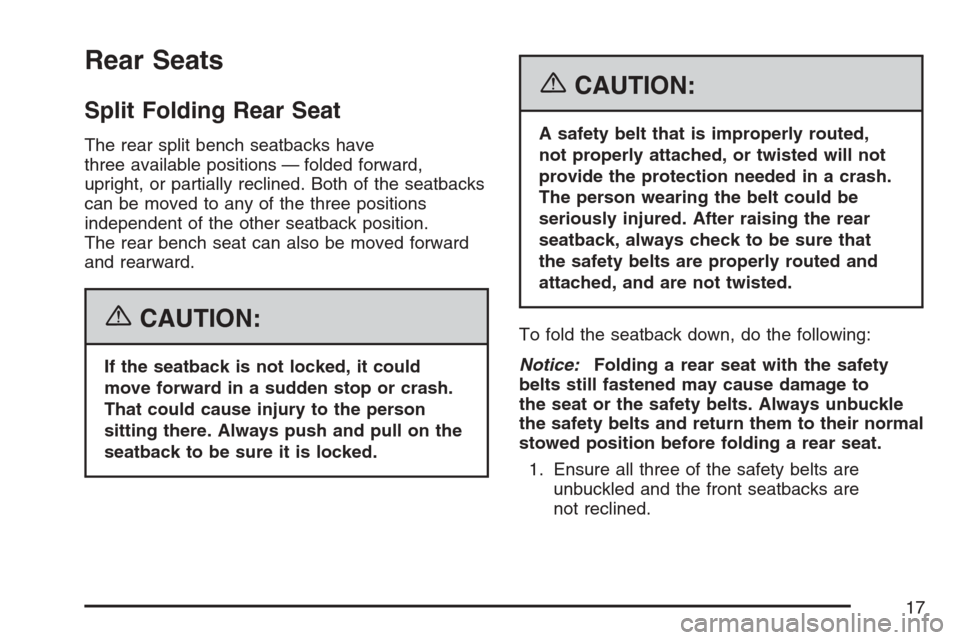
Rear Seats
Split Folding Rear Seat
The rear split bench seatbacks have
three available positions — folded forward,
upright, or partially reclined. Both of the seatbacks
can be moved to any of the three positions
independent of the other seatback position.
The rear bench seat can also be moved forward
and rearward.
{CAUTION:
If the seatback is not locked, it could
move forward in a sudden stop or crash.
That could cause injury to the person
sitting there. Always push and pull on the
seatback to be sure it is locked.
{CAUTION:
A safety belt that is improperly routed,
not properly attached, or twisted will not
provide the protection needed in a crash.
The person wearing the belt could be
seriously injured. After raising the rear
seatback, always check to be sure that
the safety belts are properly routed and
attached, and are not twisted.
To fold the seatback down, do the following:
Notice:Folding a rear seat with the safety
belts still fastened may cause damage to
the seat or the safety belts. Always unbuckle
the safety belts and return them to their normal
stowed position before folding a rear seat.
1. Ensure all three of the safety belts are
unbuckled and the front seatbacks are
not reclined.
17
Page 18 of 492
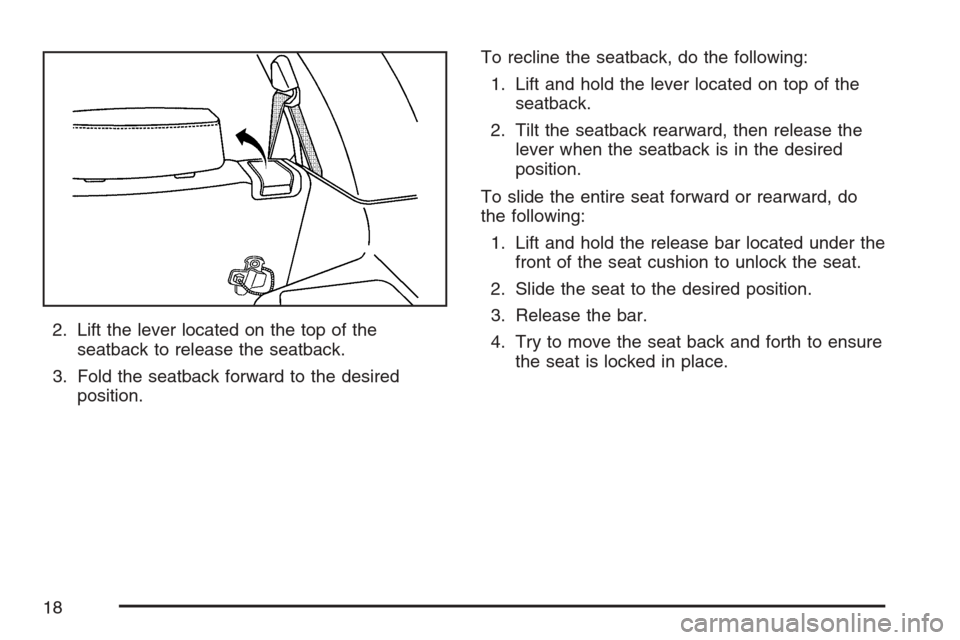
2. Lift the lever located on the top of the
seatback to release the seatback.
3. Fold the seatback forward to the desired
position.To recline the seatback, do the following:
1. Lift and hold the lever located on top of the
seatback.
2. Tilt the seatback rearward, then release the
lever when the seatback is in the desired
position.
To slide the entire seat forward or rearward, do
the following:
1. Lift and hold the release bar located under the
front of the seat cushion to unlock the seat.
2. Slide the seat to the desired position.
3. Release the bar.
4. Try to move the seat back and forth to ensure
the seat is locked in place.
18
Page 19 of 492
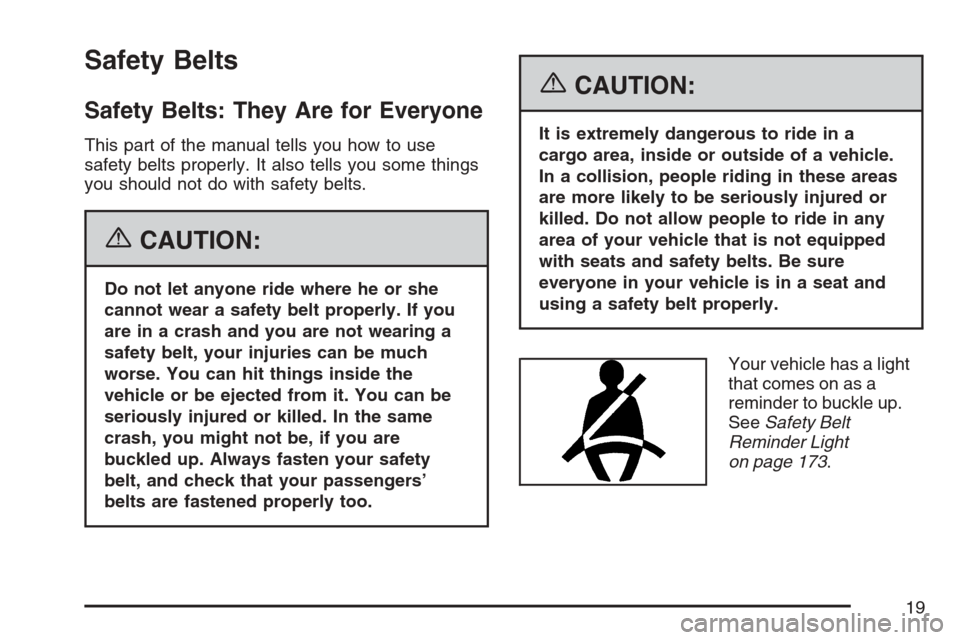
Safety Belts
Safety Belts: They Are for Everyone
This part of the manual tells you how to use
safety belts properly. It also tells you some things
you should not do with safety belts.
{CAUTION:
Do not let anyone ride where he or she
cannot wear a safety belt properly. If you
are in a crash and you are not wearing a
safety belt, your injuries can be much
worse. You can hit things inside the
vehicle or be ejected from it. You can be
seriously injured or killed. In the same
crash, you might not be, if you are
buckled up. Always fasten your safety
belt, and check that your passengers’
belts are fastened properly too.
{CAUTION:
It is extremely dangerous to ride in a
cargo area, inside or outside of a vehicle.
In a collision, people riding in these areas
are more likely to be seriously injured or
killed. Do not allow people to ride in any
area of your vehicle that is not equipped
with seats and safety belts. Be sure
everyone in your vehicle is in a seat and
using a safety belt properly.
Your vehicle has a light
that comes on as a
reminder to buckle up.
SeeSafety Belt
Reminder Light
on page 173.
19
Page 20 of 492
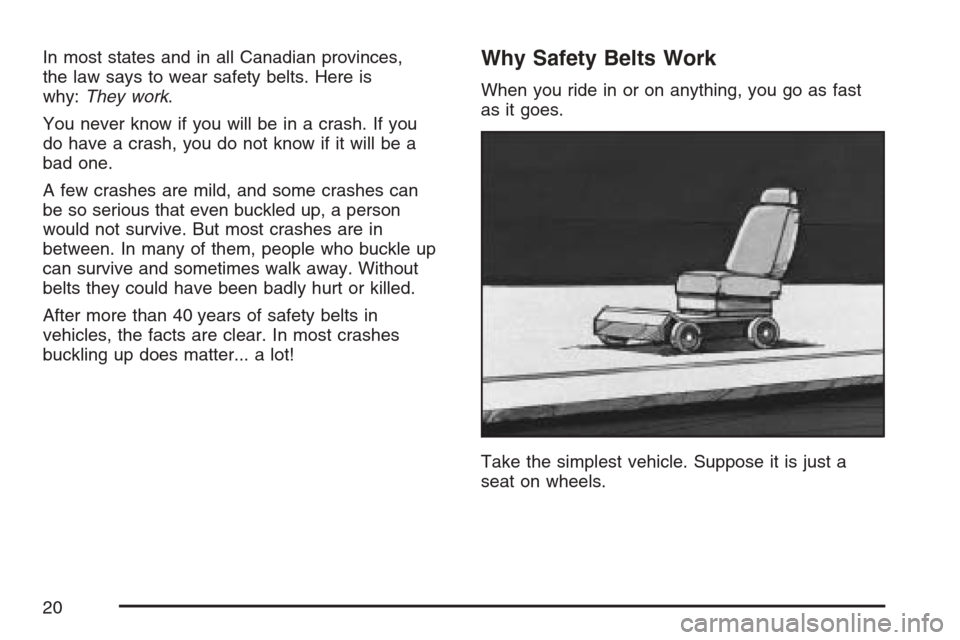
In most states and in all Canadian provinces,
the law says to wear safety belts. Here is
why:They work.
You never know if you will be in a crash. If you
do have a crash, you do not know if it will be a
bad one.
A few crashes are mild, and some crashes can
be so serious that even buckled up, a person
would not survive. But most crashes are in
between. In many of them, people who buckle up
can survive and sometimes walk away. Without
belts they could have been badly hurt or killed.
After more than 40 years of safety belts in
vehicles, the facts are clear. In most crashes
buckling up does matter... a lot!Why Safety Belts Work
When you ride in or on anything, you go as fast
as it goes.
Take the simplest vehicle. Suppose it is just a
seat on wheels.
20